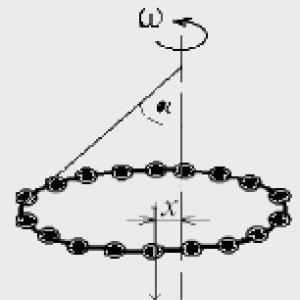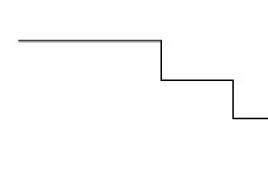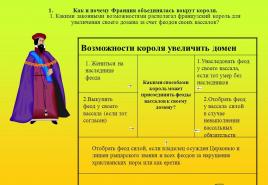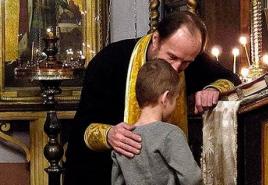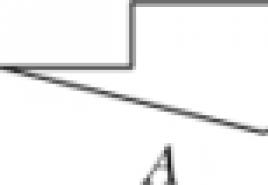I with a dash. $, £, € and crossed out "P": history of modern currency symbols
The Russian ruble has finally acquired an official graphic symbol - now the national currency will be denoted with the crossed out letter "P". About why currencies need special graphic signs and why most of the symbols of monetary units of the world have horizontal "dashes" - in the material site.
Why does currency need graphic symbols
Not every currency in the world can boast of its own sign. Thus, Latvian lats, Swiss francs, Danish, Norwegian, Swedish crowns, Croatian kunas and many other monetary units of the world can do without special characters. In total, according to the worldwide Unicode standard (standard for encoding characters and signs written languages), currently only about thirty world currencies have officially registered graphic designations. Among them there are already unused ones - for example, the signs of the Italian lira (£), the German mark (ℳ), the French franc (₣) obsolete after the introduction of the euro.
Meanwhile, it is hard not to admit that currencies with their own graphic designations are characterized by a much wider prevalence than monetary units that do not have their own symbols. Thus, the dollar ($), pound (£), euro (€), and the yen (¥) are undoubtedly not only the most popular, but also the most powerful and influential currencies in the world.
Approval of the ruble symbol
The introduction of the official symbol of the Russian ruble, according to the Bank of Russia, became the most important event in the country's economy. "Moscow claims to be an international financial center... An objective need has arisen for the introduction of a symbol of the national currency, recognized domestically and abroad, "said Elvira Nabiullina, Chairman of the Central Bank of Russia, on December 11, presenting the approved designation of the Russian currency.
The adoption of one sign as a designation of a monetary unit allows, in addition, to unify all variants of its previous spelling: so, after the official approval of the ruble symbol, you will no longer have to doubt how best to say about the ruble in written speech - 100 rubles, 100 rubles. or 100 rubles.
What the symbols of different world currencies have in common
Some of the graphical representations of monetary units developed naturally, as a result of various historical events, and some were formed during the development of many options, as well as the holding of popular votes. So, it is impossible to present any special requirements for the creation of a symbol of a particular currency. However, the graphic image must be convenient and easy to write, otherwise it will be useless - after all, currency signs are introduced in order to become recognizable and replace in writing full names currencies.

Dollar, euro, pound, Japanese yen, Vietnamese dong, Israeli new shekel
Graphic designations of almost all currencies of the world have horizontal "dashes" in their structure. It is not only the British pound sterling (£), the euro (€), the Ukrainian hryvnia (₴), the Japanese yen (¥), the Kazakhstani tenge (₸) and, finally, the symbol of the Russian ruble, which has received official status. For example, the symbols of the Indian rupee (₹), South Korean won (₩) and many other currencies of the world are also written using one or more crossed out horizontal stripes.
Such stripes on signs are a generally recognized symbol of the stability of the currency in whose spelling they are present. That is why, as the representatives of the Central Bank of Russia themselves stated, the line is also used in the ruble symbol.
From Russia with love
The approved symbol of the Russian ruble, which is the crossed out "P", is not the first symbol of the national currency, but the only one officially recognized. It should be added, however, that for a long time it was the most popular of the unofficial designations of the Russian currency.
In times Russian Empire there was another way of writing the ruble: it was a combination of the capital letters "p" and "y". According to the most common version, "p" was turned 90 degrees counterclockwise, and then "y" was written over the letter. This designation of the ruble was indicated not after the numbers, as today, but above them. However, despite the attempts of some publishers, this ruble sign did not receive wide distribution in the press.
Now the graphic symbol of the ruble has become - and already quite legally - the crossed out letter "P". This sign was approved by the Central Bank of Russia on December 11. The chosen symbol was recognized as the most popular according to the results of the voting, which the Central Bank held on its website. A one ruble coin with a new graphic symbol of the national currency will appear in circulation in 2014.

The approved designation of the ruble. Photo: cbr.ru
In early November, the Central Bank submitted for public discussion the graphic symbol of the ruble. The finalist badges were selected by a working group of the Bank of Russia from more than three thousand variants. The crossed out "P" during the voting was supported by more than 61% of the respondents.
Crossed letters and more
Since horizontal stripes are a fairly popular "attribute" of currency symbols, it is not surprising that a number of monetary units already exist in the world, the signs of which are very similar to the new designation of the ruble. So, most countries in which pesos are accepted to pay use the American dollar sign ($) or similar to indicate their currencies, with only two transverse stripes. But in the Philippines, the peso, meanwhile, is denoted by another symbol - ₱, which is similar to the new designation of the Russian ruble.

Symbols of various currencies of the world: including the American dollar, the Korean won, the Netherlands Antilles guilder
The Nigerian naira is also crossed out, though in two stripes (₦). In addition, the Ukrainian hryvnia (₴) and Lao kip (₭) have similar designations - in the form of crossed out letters.
In the graphic outlines of some national currencies, horizontal lines are present in a different way. So, the new Israeli shekel looks more like a beautiful rectangular pattern (₪), the country of Bangladesh is like solid sign from the Russian alphabet (৳), and the guilder of the Netherlands Antilles - to the mathematical notation of the function (ƒ).
Where did the most famous currency symbols come from?
Today there is no common view on the origin of the $ sign, but it is quite possible that the American currency owes its characteristic outline to the inhabitants of Foggy Albion. The fact is that english king George III ordered the use of Spanish reales in circulation, which cost 1/8 of the British pound sterling each. This money was called "piece of eight", which eventually became an abbreviated "peso". Soon they began to pay with them in the North American colonies of England, where they were also called dollars.

The strikethrough eight was reasonably chosen as the written designation for "piece of eight". However, soon this spelling turned out to be too long and inconvenient, as a result of which the symbol turned into a "truncated" eight - $.
According to the theory of American patriots, $, however, arose differently: it became a simplified combination of the letters "U" and "S" (the first letter of the name of the United States - US), superimposed on each other. Another version of the appearance of the American dollar symbol says that the "progenitors" of the $ sign were the Spaniards, who in writing designated the peso currency by combining the letters "P" and "S".
The roots of fancy writing british pound sterling are hidden in the Latin letter "L", supplemented horizontally by a line (or two lines) in the middle. The very same "L" comes from the Latin word libra (libra, pound), which denoted the main measure of weight in Ancient Rome and England.
The pound - £ or ₤ - is used not only in the UK but also in several other countries around the world.
Euro, as a young currency, received its sign as a result of analysis public opinion Europeans. It is believed that the authors of the € were four experts, whose names, for some reason, it was decided not to disclose.

According to the European Commission, the graphic representation of the euro carries the significance of European civilization (symbolized by the Greek letter "epsilon"), identity with Europe itself (the letter "E") and stability (parallel lines crossing the letter).
From $ to €
1972 dates the first use of any (some) currency symbol. It may be necessary if, for example, the sign of the required currency is not available in a computer font.

Designation of any currency
The sign of a certain currency is a circle, from which, like from the sun, four rays depart at an angle of 90 degrees in relation to each other.
Anna Teplitskaya
To hear audio examples for the text, click on the highlighted text in blue .
In Slovak, you will find many similarities to Russian. Let's start with what is usually read and written in Slovak.
Vowels
Slovak letters a, e, i/y, o, u similar to Russians and, eh, and (y \u003d hard and), about, at... Differences in pronunciation i and y no, it's a matter of writing. The same letters with a dash on top ( á
,
é
, í
/ý
, ó
, ú
) sound longer: ah, uh, uh, ooh, ooh.
The stress is usually on the first vowel of a word.
| a, á | brat, mal, málo, bál sa | |
| e, é | ten, krém, pekné, mesto | |
| i, í and y, ý | pivo, víno; syn, milý | |
| o, ó | bol, gól, ona, bola | |
| u, ú | ruka, ruku, mú, malú |
ä - soft eh
There is a separate letter for the next one - ô , she sounds like u smoothly turning into o:
AGREE
Letters b, d, f, g, k, l, m, n, p, r, s, t, z sound the same as Russians b, d, f, r, to, l, m, n, p, r, from, t, s... Letter h sounds like Ukrainian r (aspirated); ch sounds like russian x... Letter x pronounce " x" (in and-no chats and forums sometimes used as Russian x) .
Listen to some examples:
Letter v usually pronounced like Russian in - víno, Viera, however, at the end of a word and in the middle between a vowel and a consonant, it is pronounced bilabial, that is, labially, like the English W - domov, krv, polievka, pravda.
Letters q and w are found only in foreign words, for example Quido, WC.
SOFT CONSENT
All soft consonants except c, dz, j, are written with check marks (softening signs) above them.
After a soft consonant sound and spelled "soft" i (mäkké i), instead of "hard" y (tvrdé y). C sounds like russian c. Dz as dz. J like russian th.
| c | noc, práca, cena, Slovaái | |
| dz | medzi, cudzí, prichádza | |
| j | ja, Ján moje, ahoj |
Consonants č , š , ž , dž pronounced h, w, f, j.
| č | čaká, reč, Angličan | |
| š | široký, špinavý, píšeš | |
| ž | žena, môžeš, žiletka | |
| dž | džús, džem, hádže |
Ď /ď , Ť /ť , Ň /ň , Ľ /ľ sound like db, be, ny, eh.
SOFT WRITING RULE
Before letters e, i and í letters d, t, n pronounced like ď , ť , ň ... Those. the soft sign is not written.
Instead of voiced consonants, their voiceless equivalents are pronounced at the end of a word (before a pause), and before a voiceless sound:
Prepositions like v, are recognized as part of the following word:
| v meste (vmesťe) / in the city /, v kine (fkiňe) / at the cinema / | |
| s Petrom (spetrom), s matkou (zmatkou), s Dávidom |
ALPHABET
The alphabetical order of Slovak is almost the same as in English, but note that
- ch comes after h
- č , š , ž and ä , ô are considered separate letters (after c, s, z; a, o)
I think that many have already noticed that sometimes there are different icons above and below French letters: sticks, houses, dots, worms, commas ...
As you can imagine, they are drawn for a reason.
The already known letter of the alphabet e (this is the same one when we fold our lips as if we will speak about, but we ourselves say eh) with different icons is pronounced differently.
é
If you see such an icon above it (accent aigu (acute accent) or "stick to the right"), you need to pronounce it, smiling.
Prepare your lips for sound andand say it yourself eh.
That is, stretch your lips to your ears as much as possible. And with such a smile from ear to ear and speak eh.
fé e, bé bé, café, é cole, é tudie, ré cit, té lé, é té, é crire, litté rature, pré fé ré
Cé cile dé teste le café.
C "est l" é cole numé ro deux.
C "est la discipline pré fé ré e de Bé né dicte.
Le bé bé de Pé pé a le nez é paté.
Il a pitié des bé bé s.
è ê ë
The scientific name for these icons: accent grave, accent circonflexe, tréma (let's call them in our own way - stick to the left, house, two dots).
All three options are pronounced the same, like Russian eh.
trè s, prè s, aprè s, frè re, pè re, mè re, poè te, crè me, problè me, modè le
fê te, bê te, rê ve, crê pe, forê t, fenê tre, Noë l
C "est le pè re de Pierre.
Le Noë l est ma fê te préférée.
I hope everyone knows that French grew out of Latin (as did Italian, Spanish). That is, Latin roots prevail in French words.
So that's it. Where in Latin the letter s was in this root, in modern French it stands above the letter house... But in other languages \u200b\u200b(and not only Romance, but, for example, in English and Russian) this s has been preserved.
Look at the word fê te!
Let's restore the letter hidden under the house. What happened? Feste.
What does it remind us of? Look at spanish word fiesta and on russian word "the festival". Correctly! This is a "holiday"! So you can guess the meaning of the word in which there is e with a house.
And now the word forê t.
We act in the same way. Restore the letter s - forest.
Those who speak English have already understood that this is a "forest". By the way, this letter has been preserved in French, for example, in the word forestier (forester).
Two dots can stand not only above e, but also above other letters too.
The main purpose of this icon is to separate vowels.
Usually two vowels in a row give one sound. For example, the letter combination a i reads as eh (we will learn more about this later).
But if we put not one, but two dots above i, this letter combination will read as ai.
naï f, égoï ste, Raphaë l, Noë l
The house (accent circonflexe) and the "stick to the left" (accent grave) can stand not only above the letter e.
These icons can be used to distinguish the meaning of words.
du - masculine partial article (or continuous article)
dû - past tense of devoir
sur - the preposition "on, about"
a - avoir verb (to have) for the pronouns "he, she"
à - preposition "in"
ou - conjunction "or"
où - the question word “where? where?"
la - pronoun "her" (answers the question "who?")
là - adverb "there, here"
Attention! This does not affect pronunciation in any way.
ç
garç on, leç on, maç on, faç on, faç ade, limaç on, reç u
Apostrophe
This is a comma above and to the right of a letter that hides an extra vowel beneath it.
In french everything should be fine :) But two vowels in a row is a mess.
You cannot leave de elle. It is necessary to hide the vowel under the apostrophe in the preposition. It turns out d "elle.
Instead of le arbre - l "arbre, je ai - j" ai.
You get used to it very quickly, because you realize very quickly that it is really much more convenient to pronounce this way.
Lesson summary "Letters with icons":
- é (lips for sound andand say it yourself eh):
Cé cile dé teste le café. - и к л (Russian eh):
Le pè re de Noël rê ve de fê te. - ç (Russian from):
Le garç on a reç u une leç on. - apostrophe:
instead of le arbre - l "arbre, je ai - j" ai. - two dots above a vowel separate it from the previous one, that is, they do not form letter combinations, but are pronounced separately:
égoï ste, Noë l - house over vowel û distinguishes the meaning of words, does not affect pronunciation:
su r - the preposition "on, o"
sû r - adjective "confident" - stick to the left above the letter à distinguishes the meaning of words, does not affect pronunciation:
a - avoir verb (to have) for the pronouns "he, she"
à - preposition "in"

